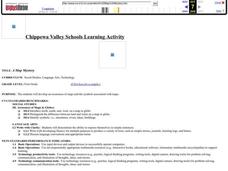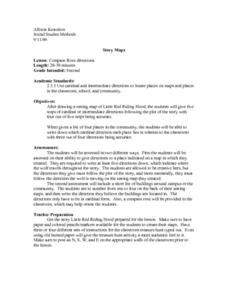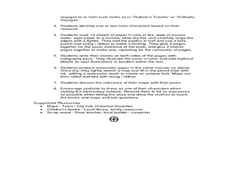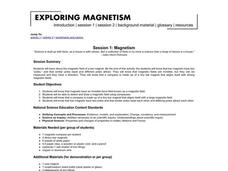Curated OER
ARE YOU A TRIANGULATEER?
Students explore about triangles and their relationship to the worlld around them. They are able to identify triangular shapes in their environment. Students are able to communicate to one another their understanding of triangles outside...
Curated OER
A Map Mystery
First graders solve a mystery by following map clues. In this map clues lesson plan, 1st graders follow a computer program called Neighborhood Map Machine. In this program, it gives students directional and spatial clues in order to...
Curated OER
Native American Homelands
Students discuss the Navajo, Sioux, and Iroquois tribes, noting their distinctive characteristics. They trace the homeland of each of the tribes on maps and create map keys. Students explain how they developed their map keys.
Curated OER
What Pie?
Students practice making and interpreting pie graphs so they are better able to decide if a pie chart is the appropriate form of display. Students examine included overheads of different pie charts, and directions on how to make pie...
Curated OER
Electricity
Students explore electricity. After watching a PowerPoint presentation, students discuss the composition of electricity and how it is made. They participate in discovery activities by rotation through four activity stations set up on the...
Curated OER
Compass Rose Directions
Second graders use cardinal and intermediate directions to locate places on maps and places in the classroom, school, and community. They draw a setting map of "Little Red Riding Hood." Students give five steps of cardinal or...
Curated OER
The Sexton and the Compass
Students evaluate how movement patterns create and affect interdependence. They analyze the interactions within and between regions and engage in artistic inquiry, exploration, and discovery in collaboration with others. They design...
Science Matters
Finding the Epicenter
The epicenter is the point on the ground above the initial point of rupture. The 10th lesson in a series of 20 encourages scholars to learn to triangulate the epicenter of an earthquake based on the arrival times of p waves and s...
Province of Manitoba
The Outdoors Camping and Survival Skills
Equip young campers with the tips and strategies for a safe trip to the outdoors with a series of lessons. They learn how to start fires with and without firewood, keep warm in snowy weather, and purify water to make it safe for drinking.
Science Matters
Volcano Models
More than 80 percent of the earth's surface originated from volcanoes. The 16th lesson in a 20-part series introduces the shape and development of volcanoes. It begins with a demonstration using a balloon and flour to illustrate the...
Curated OER
Classroom Triangles
Middle schoolers use bearing measurements to triangulate and determine objects' locations. Working in teams of two or three, students must put on their investigative hats as they take bearing measurements to specified landmarks in their...
Curated OER
Mystery Photo!
Students examine a photo of the compass plant, and research how the pioneers used the plant as a way of orienting themselves while travelling through the prairies. They analyze the photograph, and complete a Photo Analysis Guide Worksheet.
Curated OER
Magnetic Fields and Bermuda Triangles
Students map magnetic fields of a magnet using a compass and predict where fields cancel each other to create 'Bermuda Triangles'. In this magnetism lesson, students use a compass to map the magnetic field of a magnet. They explain how...
Curated OER
Which Way Is North?
Students investigate the concept of finding locations with the use of a compass and a map. They practice the skill of bearing and set up courses of travel to different destinations around the school grounds. Students also practice taking...
Curated OER
Magnetism
Students examine the concept of magnetism by doing several activities using magnets and compasses. They explore poles and polar repulsion and attraction.
Curated OER
Cardinal and Ordinal Directions
Students use a compass to locate cardinal and ordinal directions. In small groups, they describe and create a journey for their classmates using their compass. Groups create a scale map for their classmates to follow and relate this...
Curated OER
Where is Here?
Learners are shown the very basics of navigation. The concepts of relative and absolute location, latitude, longitude and cardinal directions are discussed, as well as the use and principles of a map and compass.
Curated OER
Magnets: They Are Totally Attractive
Students classify objects that magnets are attracted to and aren't attracted to. They also magnetize metal. They construct and use a compass. They develop a product which show they explain the properties of magnetism.
Curated OER
Finding Magnetic Fields of Earth
Fifth graders, in groups, create paper bag "globes", complete with magnetic poles. They use compasses to determine and label various locations (N. and S. Poles, Prime Meridian, Equator, etc.) and finish it by drawing in the continents...
Curated OER
Water Pollution Lesson Plan: All Messed Up
Young scholars map and calculate the area of the school parking lot and then the volume of water falling on the school parking lot. They map the route surface runoff will take to the nearest water body and describe the roles that human...
Curated OER
Second Class Rank: merit badge
In this second class rank worksheet, students fill out short answer questions using their workbook about compasses, safety, protection, swimming, and more in order to get a merit badge. Students complete 13 questions total.
Curated OER
Introduction to Magnets
Students explore magnetism, electromagnetism, and static electricity through a series of activities and experiments. In this magnets lesson, students use magnets to observe the forces of attraction and repulsion between different poles....
Curated OER
The Structure of the Periodic Table
Learners investigate the periodic table, the structure of the atom and the subatomic particles. In this periodic table lesson plan, students complete 5 activities in order to better understand atoms and the periodic table. They use...























